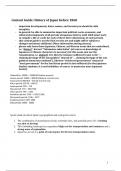Resume
History of Japan before 1868: Summary (F0TC9A)
- Établissement
- Katholieke Universiteit Leuven (KU Leuven)
- Book
- Japan to 1600
Deze samenvatting is gebaseerd op de content Gide gegeven door de prof in Toledo. In de samenvatting heb ik dat basis gebruikt en alles een beetje gelinkt om het zo gestructureerd mogelijk te presenteren. Het originele document word bijgevuld met notities van de les en informatie van de presentat...
[Montrer plus]




